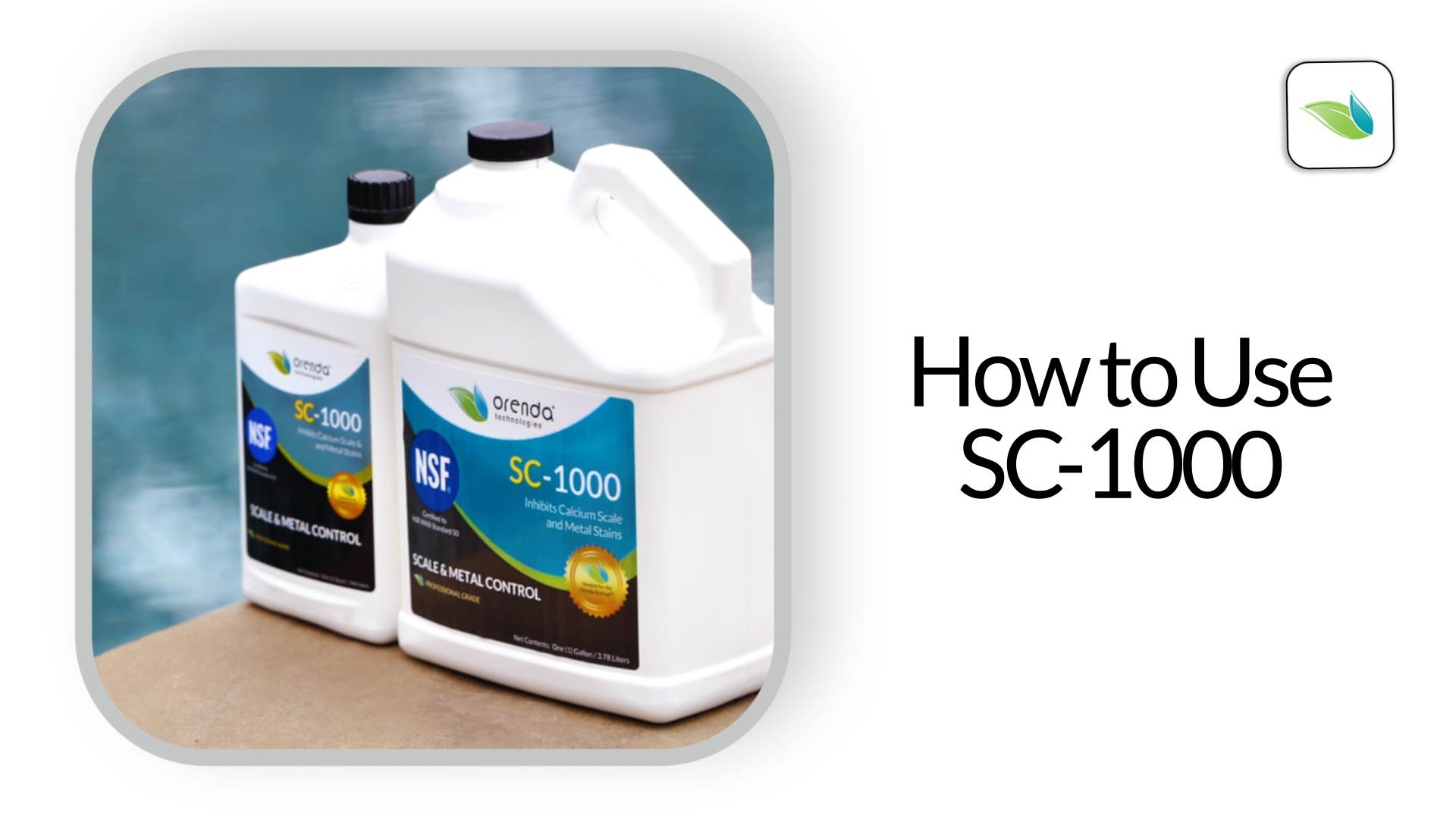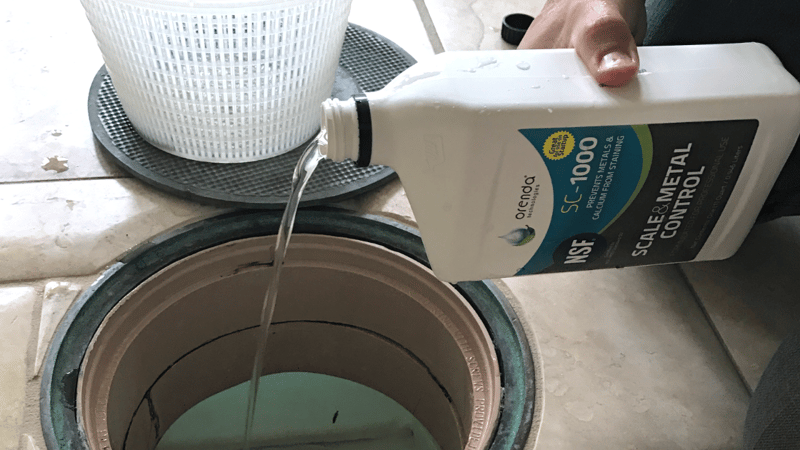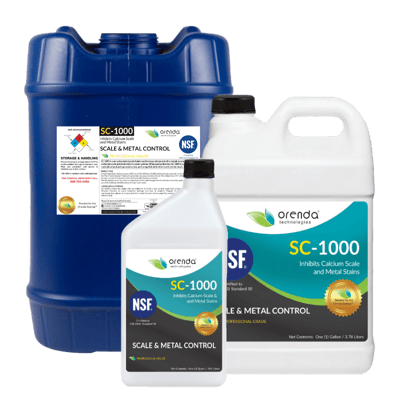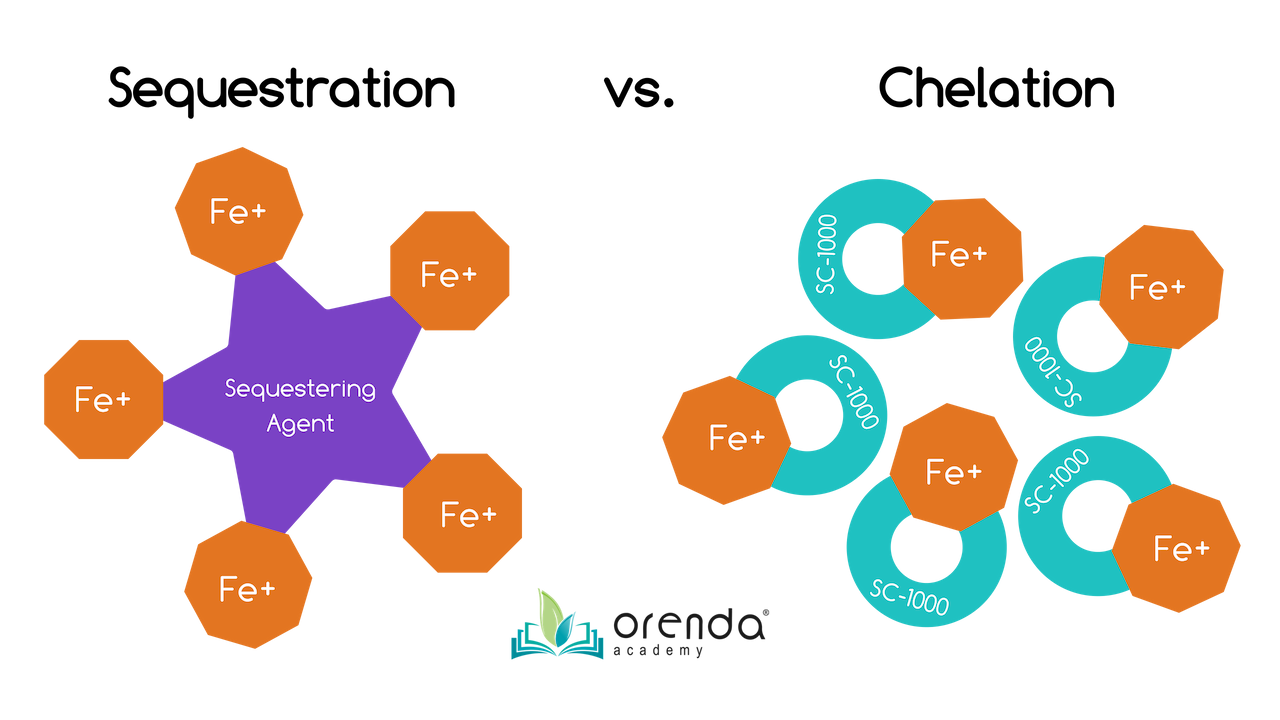How to Use SC-1000

How to use SC-1000
Overview
SC-1000 is our chelating agent. It binds to metals and minerals, preventing metal oxidation and staining, and inhibiting carbonate scale formation. This procedure covers different ways it can be used in your swimming pool, proper dosing instructions, and frequently asked questions (FAQs).
Related: How to Implement the Orenda Program
You may need:
-
- Plastic measuring cup (for liquids)
SC-1000 dosing rates
SC-1000 has two dosing rates: the initial purge dose, and the weekly maintenance dose.
|
SC-1000 Dose |
Dose per 10,000 gallons (37,900 L) |
| Purge/Startup | 32 fl. oz. (0.94 L) |
| Purge (high metals) | 48 fl. oz. (1.42 L) |
| Weekly | 3 fl. oz. (89 mL) |
NOTE: If your tap water is from a well, we recommend 1.5x the purge dose, which is 48 fl. oz. per 10,000 gallons. This is to account for the likely high metal content in the water.
Ideally, a pool is purged with SC-1000 during its initial fill, called startup. We also recommend one annual purge in the springtime to address any metals or minerals that may have accumulated during the winter months.
Weekly maintenance may not be necessary unless the pool is sourced from well water with high metals, or if staining and scale formation are occurring. If so, just 3 fl.oz./10,000 gallons should be enough to address new metals/minerals introduced from the tap water.
Where and how to pour SC-1000 into a pool

SC-1000 should be added directly into a skimmer or gutter. We want it to be circulated immediately. If you are operating a commercial or residential pool with chemical automation, the feeder for SC-1000 should be plumbed into the return line as the last injection point prior to the pool itself.
Measure the SC-1000 with a plastic measuring cup and pour it directly into the skimmer or gutter. No dilution is necessary. For startups, follow the Orenda Startup™ process.
Scale removal and prevention
SC-1000 is excellent at preventing scale formation. It is also good at dissolving existing scale that it can soak over time. If the scale is above the water line, SC-1000 cannot reach it.
To remove scale, raise the waterline by plugging the overflow(s) to soak the affected areas. If the scale is on a spillway or waterfall, run those features so that water is soaking the affected areas most of the day. Dose SC-1000 appropriately and maintain your LSI in the yellow (-0.30 to -0.01 LSI) on the Orenda app. Brush the areas regularly to speed up the removal process.
Note: scale removal takes time. Unlike acid, SC-1000 does not aggressively attack calcification. It gently dissolves it back into solution.
To prevent scale, simply maintain LSI balance. If you need help with certain areas, maintain SC-1000 with the weekly maintenance dose after purging once a year.
Stain removal and prevention
SC-1000 is excellent at preventing stains. It is not great at removing them, but with the help of citric acid, SC-1000 can be effective. To be clear, stain removal is not an Orenda specialty. SC-1000 was not made to clean up existing stains.
Preventing stains, however, is something SC-1000 does very well. It binds to metals and prevents them from being oxidized. And since SC-1000 itself cannot be oxidized by chlorine, it provides long-term stain prevention.
To remove metal stains, you will need some form of citric/ascorbic acid (aka vitamin C). Ideally, have enough SC-1000 in the water prior to the citric acid treatment so that SC-1000 is available to grab the metals that citric acid lifts from the pool surfaces.
SC-1000 considerations
SC-1000 is temperature-sensitive. The warmer the water, the better and faster it works. The colder the water, the slower it works. At some point–around 65ºF (18.3ºC)–the water is cold enough that SC-1000 may go dormant and not activate at all. This is why we advise against adding SC-1000 at closing in the fall. Instead, we recommend purging in the spring when the water is warming up. You can even add it prior to 65ºF because you know the water temperature will be warming up in the coming weeks. SC-1000 can patiently wait in cold water until it activates.
SC-1000 conflicts with chlorine until it has chelated a metal or mineral. Chlorine tries to oxidize SC-1000 but fails. This means a purge of SC-1000 will wipe out free chlorine levels for a few days if you do not give SC-1000 time to do its job (find metals/minerals and chelate them). One way around this is to divide the purge dose into three or four smaller doses over several days or weeks, which allows for less chlorine loss, while still addressing the metals/minerals gradually.
SC-1000 is biodegradable but immune to sunlight and chlorine oxidation. As mentioned in the last paragraph, chlorine tries to oxidize SC-1000 but fails. And unlike most sequestering agents, SC-1000 is immune to sunlight degradation too. This means SC-1000 has staying power in the water. But true to our Orenda philosophy, it leaves behind no harmful byproducts. SC-1000 itself is biodegradable, so when you drain your pool (or even splash it out, backwash some of it, etc.), SC-1000 will not harm the environment. Bacteria can consume it. And that's fine because such bacteria cannot survive in a chlorinated pool.
SC-1000 FAQs
 How long until it is safe to swim after using SC-1000?
How long until it is safe to swim after using SC-1000?
Like all Orenda products, SC-1000 is certified to NSF/ANSI Standard 50. That means when used as directed, SC-1000 is nontoxic and nonhazardous in your water. The only concern is free chlorine levels after the purge dose. If you are just doing the weekly maintenance dose, you will not notice a chlorine reduction. It is safe to swim once you are able to hold an acceptable free chlorine level.
Does SC-1000 leave behind a residual?
Yes. SC-1000 will stay bound to your metals and minerals indefinitely. These bound metals/minerals are unable to be oxidized or carbonated, and they are harmless. The reason for a weekly maintenance dose is to address new metals/minerals introduced from the tap water or from other products added to the pool.
How does SC-1000 compare to other sequestering agents?
SC-1000 is not a sequestering agent; it's a chelating agent. Chelation is different than sequestration, though the net result is similar.
 Sequestering agents are like metal/mineral magnets. They attract several ions of metals to them, creating a larger molecule. Chelants like SC-1000 individually isolate ions of metal or minerals. These stay separated. So if you're trying to filter out metals/minerals, a sequestering agent might be a better fit for you. But if you're trying to manage metals/minerals for the long-term (think calcium hardness), then SC-1000 is a better fit because of its staying power.
Sequestering agents are like metal/mineral magnets. They attract several ions of metals to them, creating a larger molecule. Chelants like SC-1000 individually isolate ions of metal or minerals. These stay separated. So if you're trying to filter out metals/minerals, a sequestering agent might be a better fit for you. But if you're trying to manage metals/minerals for the long-term (think calcium hardness), then SC-1000 is a better fit because of its staying power.
Another thing to consider is that most sequestering agents are phosphate-based. This means a phosphate remover like PR-10,000 will wipe them out. When that happens, the metals/minerals that were once bound up become free to be oxidized or carbonated. SC-1000 contains no phosphates and is compatible with all other Orenda products.
What else can SC-1000 be used for?
We primarily use SC-1000 for startups, annual purging, and scale prevention. But it can also be used to rapidly dechlorinate a pool if circumstances require it. It is a safer alternative to sodium thiosulfate for dechlorination because it leaves behind no sulfates.
Can SC-1000 be used in saltwater pools?
Yes.
What is the shelf life of SC-1000?
Indefinite shelf life (100+ years), provided the product does not freeze.
